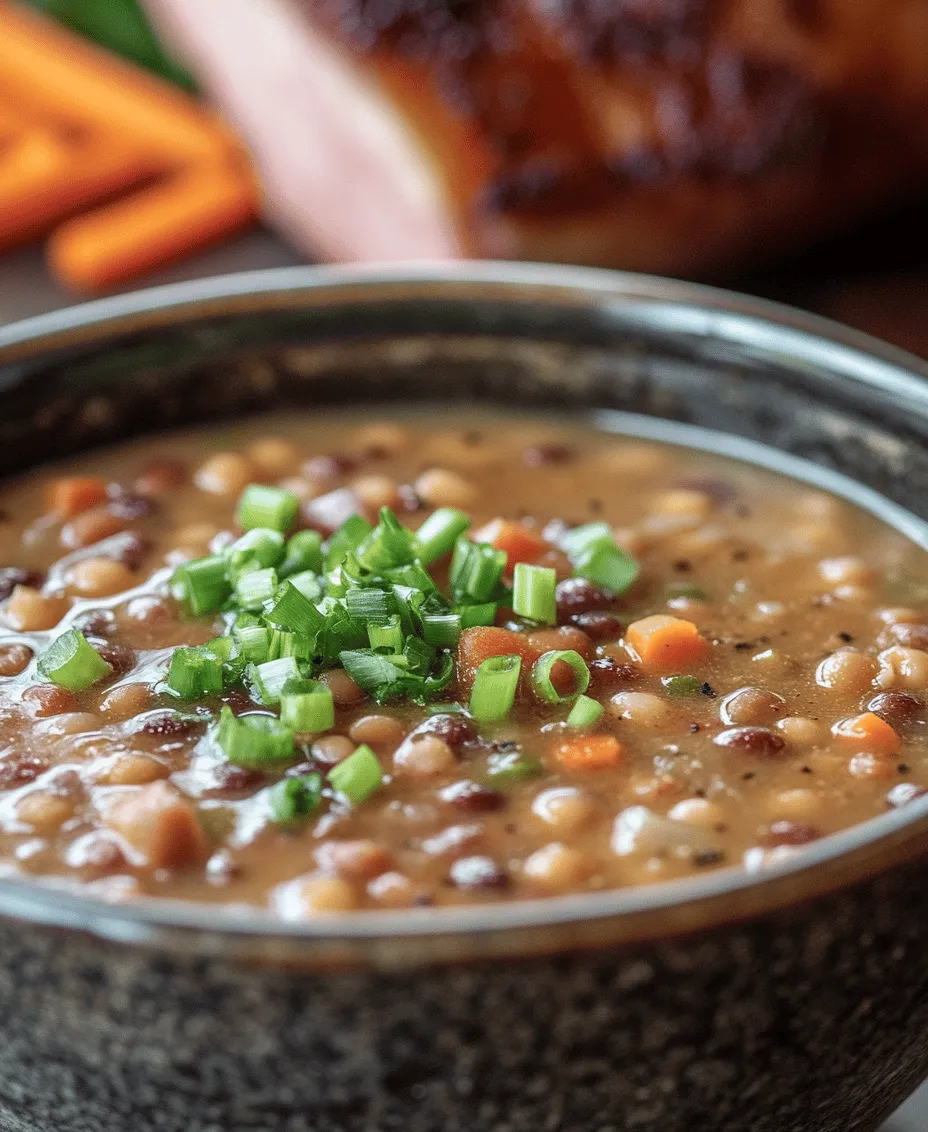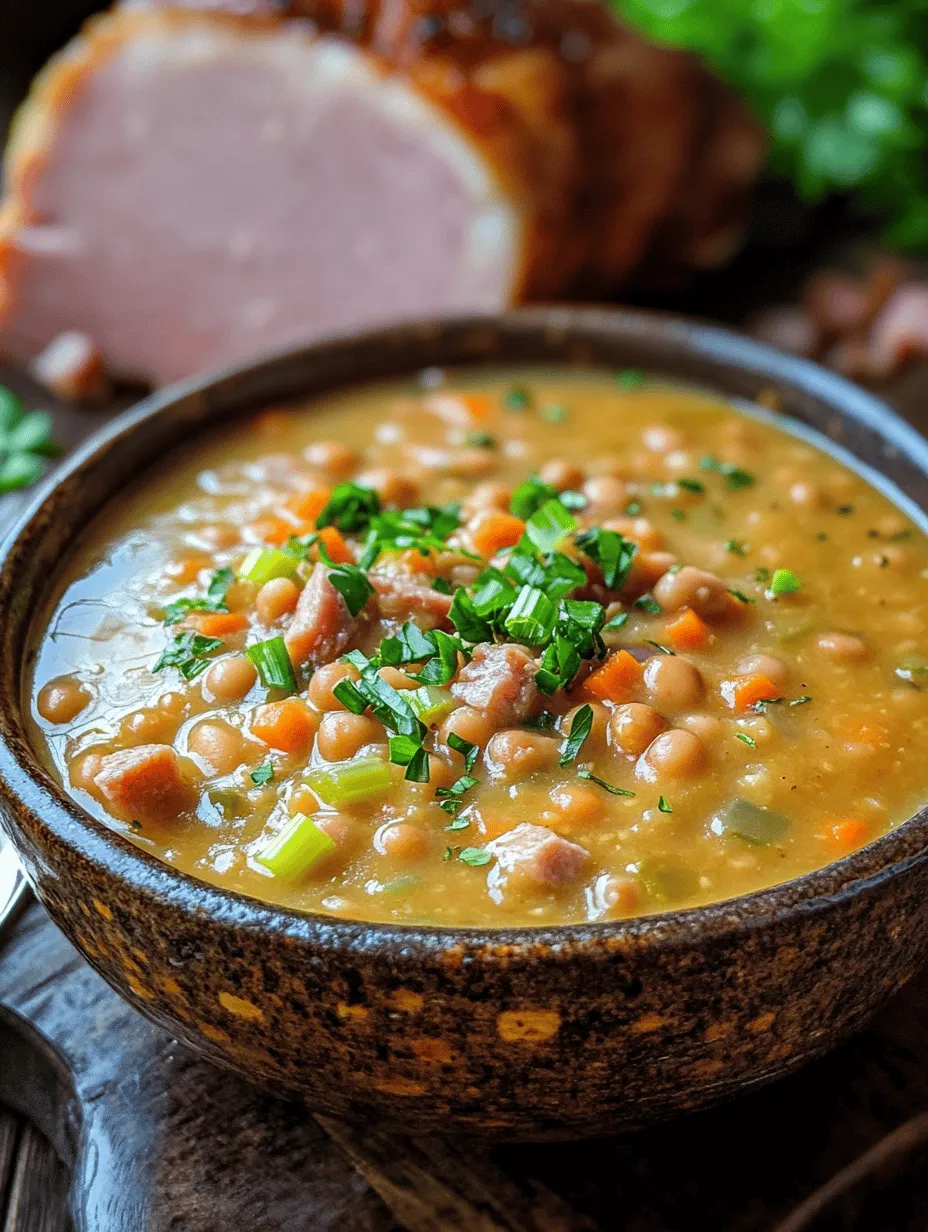Introduction
Southern cuisine is renowned for its rich flavors, hearty ingredients, and deep-rooted traditions. Among the many staples that grace Southern tables, black-eyed peas hold a special place, especially during New Year’s Day celebrations. These humble legumes symbolize good luck and prosperity, making them an essential dish for those looking to start the year off right. The tradition of consuming black-eyed peas on January 1st dates back centuries, and their cultural significance continues to resonate in homes across the South.
But black-eyed peas are not just a one-day wonder; they are versatile ingredients that can be incorporated into various dishes throughout the year. Whether you’re a vegetarian looking for a nutritious meal or a meat-lover seeking a flavorful side, our Southern-Style Smoky Black-Eyed Peas recipe has something to offer everyone. This dish combines the robust flavors of smoked ingredients with the wholesome goodness of black-eyed peas, making it a must-try for any home cook.
Beyond their delicious taste, black-eyed peas are packed with health benefits. They are a fantastic source of protein, fiber, and essential vitamins, making them an excellent choice for anyone looking to boost their nutritional intake. With their low caloric content and high nutrient density, black-eyed peas support digestive health and can aid in weight management, proving that comfort food can also be good for you.
In this article, we will guide you through the process of creating Southern-Style Smoky Black-Eyed Peas. From understanding the unique characteristics of black-eyed peas to detailed preparation steps, you’ll learn everything you need to know to make this delightful dish.
Understanding Black-Eyed Peas
Black-eyed peas, scientifically known as Vigna unguiculata, are a variety of cowpea. They are small, beige legumes with a distinctive black spot resembling an eye, which gives them their name. Originating in West Africa, black-eyed peas were brought to the Americas via the transatlantic slave trade and have since become a cornerstone of Southern cooking. Their earthy flavor and creamy texture make them a favorite in various dishes, from salads to stews.
Nutritionally, black-eyed peas are a powerhouse. A one-cup serving of cooked black-eyed peas contains approximately 160 calories, 13 grams of protein, and 11 grams of fiber. They are also rich in vitamins A, C, and several B vitamins, which contribute to maintaining a healthy immune system and energy levels. The high fiber content promotes digestive health and can help regulate blood sugar levels, making black-eyed peas an excellent choice for those managing diabetes.
In Southern traditions, black-eyed peas are often prepared with various meats and spices, adding to their flavor profile. On New Year’s Day, they are typically served alongside cornbread and collard greens, creating a meal that is not only delicious but also symbolic of good fortune and prosperity for the year ahead.
Ingredients Breakdown
Before diving into the preparation of our Southern-Style Smoky Black-Eyed Peas, let’s take a closer look at the key ingredients that make this dish special.
Dried vs. Canned Black-Eyed Peas
When it comes to selecting black-eyed peas for your recipe, you have two primary options: dried or canned. Dried black-eyed peas are a more economical choice, allowing you to control the seasoning and texture. However, they do require soaking and longer cooking times. On the other hand, canned black-eyed peas offer convenience and a quicker preparation time, making them ideal for busy weeknights. If you choose canned, be sure to rinse them well to remove excess sodium.
The Role of Broth
The depth of flavor in your black-eyed peas largely depends on the broth you choose to use. Vegetable broth can provide a rich, savory base for vegetarian versions of the dish, while chicken broth offers a heartier flavor for those who enjoy meat. Using broth instead of plain water elevates the overall taste of the dish, infusing it with additional umami notes.
Importance of Aromatics
Aromatics are the building blocks of flavor in many dishes, and black-eyed peas are no exception. For this recipe, we’ll use a combination of onion, garlic, carrot, and celery. These ingredients not only add flavor but also contribute to the dish’s overall texture. Sautéing these aromatics before adding the peas will enhance their natural sweetness and create a flavorful foundation.
Smoked Ham Hock vs. Smoked Paprika
For those seeking a smoky flavor, smoked ham hock is a traditional ingredient in Southern-style black-eyed peas. It adds richness and depth, infusing the dish with savory notes. However, for a vegetarian alternative, smoked paprika is an excellent substitute. This spice provides a similar smoky essence without the meat, making it perfect for those who prefer plant-based options.
Additional Seasoning
To further enhance the flavors of your Southern-Style Smoky Black-Eyed Peas, we’ll incorporate bay leaves, thyme, salt, and pepper. These seasonings work together to create a well-rounded taste profile that complements the earthy flavors of the peas and the smokiness of the ham or paprika.
The Finishing Touch: Apple Cider Vinegar and Garnishes
The final touch to elevate your dish is a splash of apple cider vinegar. This ingredient adds a tangy brightness that balances the richness of the other components. Additionally, garnishing with fresh herbs, such as parsley or cilantro, adds a pop of color and freshness to the plate.
Preparation Steps
Now that we’ve covered the ingredients, let’s delve into the preparation steps for our Southern-Style Smoky Black-Eyed Peas.
Preparing the Peas
If you’ve chosen dried black-eyed peas, the first step is to soak them. Soaking not only reduces cooking time but also enhances digestibility by breaking down some of the compounds that can cause discomfort. You can soak your dried peas overnight in a large bowl of water or use the quick soak method: bring them to a boil for two minutes, then remove from heat and let them sit for one hour. After soaking, rinse the peas under cold water and set them aside.
For those using canned black-eyed peas, simply rinse them thoroughly under cold water to remove any excess sodium. This step is crucial to ensure a clean taste and to avoid any canned flavor.
Sautéing Aromatics
With your black-eyed peas prepped, it’s time to sauté the aromatics. Begin by heating a tablespoon of olive oil or butter in a large pot over medium heat. Once hot, add diced onion, minced garlic, chopped carrots, and diced celery. Sauté the aromatics, stirring occasionally, until the onion is translucent and the vegetables are tender, usually about 5 to 7 minutes. This step is essential for developing the flavors that will permeate the entire dish.
Tips for Sautéing
Achieving the right texture and flavor when sautéing is crucial for a successful dish. Make sure not to overcrowd the pan; if necessary, sauté in batches to prevent steaming rather than browning. Maintain a medium heat to ensure the vegetables cook evenly without burning. Stir frequently to promote even cooking and to prevent sticking.
Once the aromatics are beautifully softened and fragrant, it’s time to add your prepared black-eyed peas, broth, and seasonings. The next steps will guide you through creating this comforting dish that embodies the spirit of Southern cooking.
In the following sections, we’ll explore the final steps to bring your Southern-Style Smoky Black-Eyed Peas to life, ensuring that you can serve a dish that’s not only delicious but also steeped in tradition and health benefits.

Combining Ingredients
Layering flavors is essential in creating a rich and satisfying dish like Southern-Style Smoky Black-Eyed Peas. Begin by sautéing your aromatics—onions, garlic, and bell peppers—in a large pot or Dutch oven. This initial step not only softens the vegetables but also allows them to release their natural sweetness, which serves as the foundation of flavor for your dish. Once these ingredients are fragrant and translucent, it’s time to add your black-eyed peas, along with any spices or seasonings such as smoked paprika, cayenne pepper, and bay leaves.
Integrating these spices at this stage helps them bloom, releasing their essential oils and enhancing the overall flavor profile of your dish. Stir the mixture well to ensure that the spices coat the peas evenly, allowing each bite to be infused with that signature Southern smokiness.
The Significance of Stirring Well for Even Cooking
Stirring is a crucial step that should not be overlooked. A gentle but thorough stir helps to combine all ingredients and ensures that nothing sticks to the bottom of the pot, which can lead to uneven cooking or burning. As you continue to stir, pay attention to the texture of the peas; they should feel slightly firm yet tender as they absorb the flavors from the pot. This mixing process not only aids in heating but also promotes a harmonious blend of flavors that is characteristic of Southern cooking.
Simmering: Adjusting Cooking Times Based on Pea Type
Once you have combined all your ingredients, it’s time to let them simmer. The cooking time can vary significantly based on the type of black-eyed peas you are using. Dried peas typically require about 30-45 minutes of simmering, whereas canned black-eyed peas, which are already cooked, will only need about 10-15 minutes to heat through and absorb the flavors of the broth. To ensure optimal texture, check the peas periodically. They should have a creamy consistency, and if they appear too firm, continue to simmer for additional time.
Signs That the Peas Are Ready: Texture and Creaminess Indicators
Knowing when your black-eyed peas are ready is key to achieving a perfect dish. The peas should be tender and creamy without falling apart. A good test is to take a few peas and gently mash them between your fingers. If they yield easily but still hold their shape, you’re on the right track. The broth should be flavorful and slightly thickened, clinging to the peas and providing a luscious mouthfeel.
Adjusting Flavors: Integrating Shredded Meat and Balancing Acidity with Vinegar
If you’re looking to incorporate shredded meat, such as smoked ham hocks or pulled pork, now is the time to add it to the pot. This addition deepens the smoky flavor and adds a satisfying heartiness to the dish. Be mindful of the balance of flavors; if you find the dish becoming too rich, a splash of vinegar—whether apple cider or white vinegar—can brighten the flavors and add a necessary acidity. Start with a small amount, taste, and adjust as necessary.
Importance of Tasting and Adjusting Seasoning to Personal Preference
As with any recipe, tasting is an invaluable step. As the dish simmers, regularly taste the black-eyed peas and adjust the seasoning as needed. You might want to enhance the flavor with additional salt, pepper, or even a hint of hot sauce for those who enjoy a spicy kick. Remember that seasoning is personal; what might taste perfect to one person may need a bit more or less for another.
—
Serving Suggestions
Presentation plays a crucial role in making a dish appealing, and your Southern-Style Smoky Black-Eyed Peas can shine with just a few thoughtful touches. Serve the peas in a rustic bowl or a deep dish, allowing the vibrant colors and textures to take center stage. For an inviting look, consider placing a small bouquet of fresh herbs, such as parsley or cilantro, on top of the dish.
Pair your black-eyed peas with traditional Southern staples like cornbread, which adds a delightful crunch and sweetness that balances the smoky flavors. Alternatively, serve them over a bed of fluffy white rice, allowing the grains to soak up the rich broth. For a complete meal, consider offering a side of collard greens or cornbread muffins, enhancing the Southern experience.
Optional garnishes can elevate the dish further. Chopped green onions bring a fresh, bright flavor, while a dash of hot sauce can add an extra layer of heat for those who crave it. A sprinkle of freshly cracked black pepper can also enhance the visual appeal and flavor profile.
Health and Nutritional Benefits
Black-eyed peas are not just delicious; they are also packed with health benefits. These legumes are high in protein and fiber, making them an excellent choice for a balanced diet. One cup of cooked black-eyed peas contains about 170 calories, 13 grams of protein, and 11 grams of dietary fiber, contributing to feelings of fullness and aiding digestion.
In addition to being nutrient-dense, black-eyed peas are also rich in vitamins and minerals, including folate, magnesium, and iron. The other ingredients in your dish, such as onions and garlic, also provide health benefits, including antioxidants and anti-inflammatory properties. Incorporating black-eyed peas into your meals can promote heart health, support weight management, and contribute to overall wellness.
To include black-eyed peas in a healthy meal plan, consider preparing them as a side dish, incorporating them into salads, or using them as a base for grain bowls. Their versatility allows them to complement various cuisines and dishes.
Cultural Significance and Variations
Black-eyed peas hold a special place in Southern culinary traditions, often associated with good luck, particularly when eaten on New Year’s Day. This cultural significance stems from the belief that consuming these peas will bring prosperity and good fortune in the coming year. Across the Southern United States, you’ll find numerous variations of black-eyed pea recipes, each reflecting local ingredients and cooking styles.
In different regions, you may encounter variations that incorporate local spices or other ingredients, such as tomatoes or different types of meat. These adaptations highlight the creativity and diversity of Southern cooking.
If you’re looking to explore vegetarian or vegan adaptations of this recipe, consider substituting meat with smoked paprika or liquid smoke for that signature smoky flavor. You can also enhance the dish with additional vegetables, such as carrots or celery, to add more depth and nutrition while keeping the dish plant-based.
Conclusion
Southern-Style Smoky Black-Eyed Peas are not just a delicious meal; they are a reflection of Southern culture and tradition. Their rich flavors, comforting texture, and nutritional benefits make them a fantastic addition to any table. Whether you are enjoying them as a hearty main dish or as a side to complement a larger meal, this recipe is sure to become a favorite in your household.
We encourage you to try this recipe for a comforting and hearty dish that warms the soul. Share this dish with family and friends, creating new traditions and memories around the dining table. By doing so, you are not only enjoying a delicious meal but also fostering community and celebrating the rich culinary heritage of the South.

